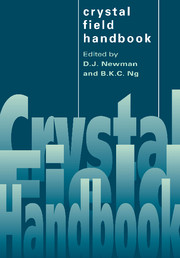Book contents
- Frontmatter
- Contents
- List of contributors
- Preface
- Introduction
- 1 Crystal field splitting mechanisms
- 2 Empirical crystal fields
- 3 Fitting crystal field parameters
- 4 Lanthanide and actinide optical spectra
- 5 Superposition model
- 6 Effects of electron correlation on crystal field splittings
- 7 Ground state splittings in S-state ions
- 8 Invariants and moments
- 9 Semiclassical model
- 10 Transition intensities
- Appendix 1 Point symmetry
- Appendix 2 QBASIC programs
- Appendix 3 Accessible program packages
- Appendix 4 Computer package CST
- Bibliography
- Index
3 - Fitting crystal field parameters
Published online by Cambridge University Press: 10 December 2009
- Frontmatter
- Contents
- List of contributors
- Preface
- Introduction
- 1 Crystal field splitting mechanisms
- 2 Empirical crystal fields
- 3 Fitting crystal field parameters
- 4 Lanthanide and actinide optical spectra
- 5 Superposition model
- 6 Effects of electron correlation on crystal field splittings
- 7 Ground state splittings in S-state ions
- 8 Invariants and moments
- 9 Semiclassical model
- 10 Transition intensities
- Appendix 1 Point symmetry
- Appendix 2 QBASIC programs
- Appendix 3 Accessible program packages
- Appendix 4 Computer package CST
- Bibliography
- Index
Summary
This chapter is concerned with the most frequently encountered problem in crystal field theory, namely the calculation of a set of crystal field parameters from experimentally determined crystal field split energy levels. An iterative least-squares fitting procedure is generally required, as follows.
(i) Estimate initial values of the crystal field parameters for the system under consideration.
(ii) Construct the energy matrix using estimated or previously calculated crystal field parameter values.
(iii) Diagonalize the energy matrix to obtain its eigenvalues, which correspond to estimated positions of the energy levels.
(iv) Set up one-to-one correspondences between the experimental and calculated energy levels.
(v) Keeping the eigenvectors of the energy matrix fixed, determine the values of the parameters that minimize the sum of squares of the differences between the calculated and experimental energy levels.
(vi) Using the set of crystal field parameter values derived in step (v), return to step (ii) and continue iterating steps (ii)–(v) until the calculated and experimental energy levels are judged to be in good enough agreement.
Initial estimates of parameter values may be based on values already obtained for a similar system, such as those listed in Chapter 2. This and other ways of estimating parameter values required for step (i) are discussed next. Program ENGYFIT.BAS carries out steps (ii)–(vi) when all the energy levels are in a single multiplet.
It is sometimes necessary to calculate, from a given set of crystal field parameters, energy levels that have not been determined experimentally. This only involves steps (ii) and (iii).
- Type
- Chapter
- Information
- Crystal Field Handbook , pp. 43 - 64Publisher: Cambridge University PressPrint publication year: 2000
- 6
- Cited by

